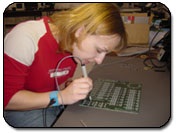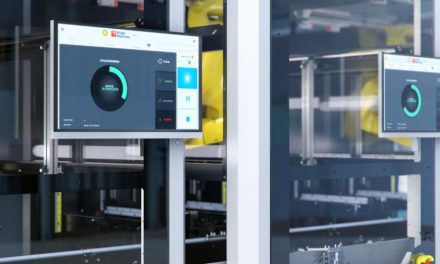Developing the Electronics Workforce through Academia-Industry Partnership

An interview with Dr. S. Manian Ramkumar, Interim Dean of Rochester Institute of Technology’s (RIT’s) College of Applied Science and Technology; Dr. Martin Anselm, Director of RIT’s Center for Electronics Manufacturing and Assembly (CEMA); and, Mr. Jeff Timms, General Manager, Americas, ASM Assembly Systems
Much has been written about the need to attract new, young talent into the electronics manufacturing industry. Here in part one of this two-part interview, we speak with Rochester Institute of Technology professors about educating future engineers and equipment supplier ASM on making hands-on experience a differentiator. Former RIT students now working in industry also share their perspective.
EMSNow: The problem solving/research aspect of RIT’s CEMA is fascinating. US Companies often don’t have access to basic research (as in the heyday of Bell Labs and NASA). How does having a manufacturing laboratory available to engineers offer benefits for solving industry challenges? Can you cite some examples? How are the results of the work shared with industry?
Dr. S. Manian Ramkumar (MR): Through RIT’s relationship with ASM and other suppliers, our students and members of the electronics industry have access to state-of-the-art equipment technology in our CEMA lab. This prepares our students for the workforce while also allowing us to provide un-biased research for companies developing electronic products or processes.
Dr. Martin Anselm (MA): Our work has covered everything from process characterization of solder pastes to feeder reliability to dispensing techniques and everything in between. Some of this is student-led and some is industry-led, but all of it has long-term benefit for the electronics community. The non-NDA work is shared through various forums such as conferences and technical papers and the proprietary work we undertake for electronics companies enables the development of next-generation product and/or process capabilities.
EMSNow: What benefits are realized from having access to advanced equipment (such as ASM’s printer and placement systems) in terms of developing a student’s knowledge base and marketability for potential future employers? How is this better/different than what could be achieved through other training programs?
MR: Advanced equipment is essential for students’ understanding of the process and the implications of equipment capability in the final quality of the product. They are better engineers because of this practical experience. But, don’t take just my word for it. Read what our students have said bout the CEMA lab and its impact on their education. (see Part Two for student comments).
MA: There is a unique benefit to having the entire lab. Because of the generous support of supplier partners like ASM, the program is immersive and holistic. Students are learning the entire process instead of one specific area, which is often the case with other training programs. Those instructional courses certainly have advantages but, for engineering students, being exposed to the SMT process comprehensively offers perspective not often experienced even in other graduate programs. And, even for those not enrolled at RIT, we offer a three- or five-day intensive manufacturing course.
EMSNow: There are other colleges and technical training schools that are trying to engage with companies to develop programs like this. How do you see this model taking hold and becoming the standard? Does it make sense for industry to subsidize students more directly in the future?
MA: Making this available to more potential engineers would be fantastic, though universities should be prepared for the financial commitment to sustaining such a resource. In addition to the CEMA lab equipment itself, there is considerable cost to maintain the advanced technologies, provide ample space and staffing, and keep all systems operational. It takes intense dedication from the university and, in our case, also supplier partners like ASM.
MR: It does make sense for industry to subsidize students more directly and there are many avenues for that such as endowed scholarships, graduate research assistanceships, endowed professorships and naming of centers, among others.
EMSNow: What types of technologies are your partners/customers asking for regarding research initiatives?
 MA: Miniaturization is always at the forefront, with smaller parts and higher-density products affecting everything up and down the line. In addition, we also conduct quite a bit of research around solder alloys and reliability. Outside of these areas, I would say Industry 4.0 and statistics are high priorities. Industry 4.0 is not just about software compatibility; it’s also having the confidence that the machines are making a decision that’s equal to or better than that of a qualified engineer. So, statistical analysis and its implementation are big areas of focus and require partnerships between several parties (software, hardware and Industry 4.0 manufacturers) to make the 4th Industrial Revolution a reality. Universities are uniquely suited to be able to conduct this kind of research – especially when you align with suppliers on the leading edge of Industry 4.0.
MA: Miniaturization is always at the forefront, with smaller parts and higher-density products affecting everything up and down the line. In addition, we also conduct quite a bit of research around solder alloys and reliability. Outside of these areas, I would say Industry 4.0 and statistics are high priorities. Industry 4.0 is not just about software compatibility; it’s also having the confidence that the machines are making a decision that’s equal to or better than that of a qualified engineer. So, statistical analysis and its implementation are big areas of focus and require partnerships between several parties (software, hardware and Industry 4.0 manufacturers) to make the 4th Industrial Revolution a reality. Universities are uniquely suited to be able to conduct this kind of research – especially when you align with suppliers on the leading edge of Industry 4.0.
Part two of this article will post November 21.












